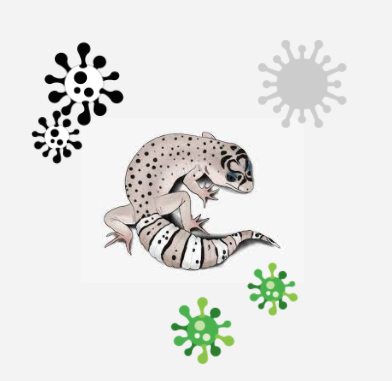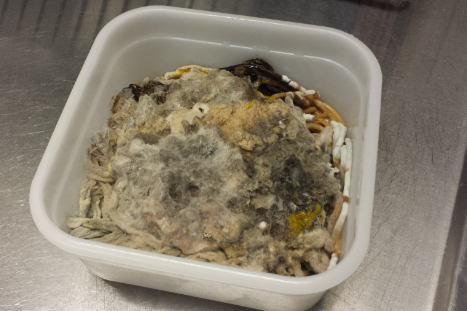Lizard Sicknesses/Diseases

March 30, 2022
Keeping your lizard healthy and happy is the main thing we want to keep track of. If your lizard comes across a sickness or a disease or you just know something isn’t right, don’t worry, read this story and hopefully make progress to get your lizard back up to 100% health. We will talk about the different sicknesses and diseases a certain lizard might have; as well as possible mites that might come with the lizard, on wood that may be in your lizard’s tank, etc. That includes us going over these four specific lizards (just like in the other stories), Bearded Dragon, Leopard Gecko, Crested Gecko, and African fat-tailed Geckos. Your lizard’s health depends on you. At the end there will be some links for more information just in case there was something I didn’t answer. Let’s get started!
First we will begin with mites. Personally, I don’t know what that’s like because my leopard gecko has never been sick and hasn’t ever had mites but that depends on what I put on his tank. Some of the real wood you get from pet stores could have some type of really small fungus or mites… We will learn together as we continue through the story. Most of the information to get rid of mites, might be the same for all these lizards or one or two, etc. We are just going to go in order as usual:
Before diving into the details of bearded dragons and mites, here are the basic facts of the matter:
- Though they are not the parasite’s preferred host, bearded dragons can suffer from snake mite infestations.
- Mites will normally appear like small red to black dots on your lizard.
- These infestations can be very difficult to treat and require extra effort on the keeper’s part for a month or more.
- Mites don’t present an acute risk, but they can cause health problems if not eradicated.
- The mites on your lizard aren’t the only problem – you’ll also have to eliminate all of the mites in the environment.
- Because mites will cause significant stress to you and your lizard, it is wisest to focus on prevention.
Symptoms- The most obvious symptom of a mite infestation is the appearance of the tiny arthropods on your pet. You’re probably most likely to notice them on the foreparts of the animal (especially around the head, neck and upper torso), but they may appear anywhere. As mentioned, mites are typically red, brown or black (or somewhere in between), and they’re about the size of a pepper flake. You may see hundreds of them if the infestation is severe, or you may only notice a single mite, which suggests that the infestation is still in its earliest stages. You may also spot mites in or around your pet’s habitat, or on your skin or clothing. In fact, this is how observant keepers often notice mite problems at an early stage, when treatment is much easier. You may also notice your lizard trying to dislodge the parasites or scratch itself.
Here is a sight that gives you enough information about mites, and how to possibly get rid of them. (this is mainly about bearded dragons.):https://www.reptileadvisor.com/bearded-dragon-mites/
This site is very helpful and has a TON of information.
Next we are moving on to Salmonella. Salmonella is a disease that can be transferred from reptiles to humans. Salmonella bacteria usually does not cause any illness in reptiles, but can cause serious illness in people. Salmonella is rarely fatal, but if the bacteria enters your bloodstream, it can be life-threatening, especially for people with weakened immune systems, such as the elderly, the very young, and those with diseases like cancer and HIV/AIDS, which is very scary to think of. But that’s why you wash your hands after touching, or holding a reptile. And you definitely need to wash your hands if your lizard pees on you or if you touch the lizard’s droppings. Attempts to treat reptiles with antibiotics to eliminate Salmonella spp. from their intestinal tract have not proven to be effective. Doing so increases the risk of emergence of antimicrobial-resistant Salmonella strains, which, if transmitted to humans, would complicate treatment of the infected person. So you can’t treat Salmonella which means we will move on to the next one.
Here is a link that talks about lizard illnesses and diseases and it talks about how to cure it, this site is really helpful and gives you a ton of information: https://petkraze.com/blog/47004/common-reptile-diseases-and-solutions
We are moved onto “Stick tail”. Stick tail is most commonly found in leopard geckos and African fat-tailed geckos. According to Petkeen, “Stick tail” is a lay term for weight loss in leopard geckos and fat-tail geckos. Often, it is caused by an intestinal infection by Cryptosporidium varanae (formerly Cryptosporidium saurophilum). Other common causes are gastrointestinal infections of flagellated protozoa or Gram-negative bacteria. The treatment for stick tail disease is dependent on the actual cause. If bacterial infection or general parasites are the culprit, they can be treated with appropriate medications from your exotic veterinarian. Avoid using over the counter or dog/cat/human medications for your reptile pet.” Here is a link so you know more about sick tail: https://reptilesmagazine.com/stick-tail-disease-in-leopard-geckos/#:~:text=%E2%80%9CStick%20tail%E2%80%9D%20is%20a%20lay,protozoa%20or%20Gram%2Dnegative%20bacteria.
And now we are onto “Tail Rot”. As you can tell, a lot of things happen in the tail of lizards. But now we are talking about a different one called tail rot. Tail rot most commonly happens in bearded dragons. Tail rot in Bearded Dragons is treatable, but needs to be taken care of quickly. Left untreated, it can be fatal. Tail rot is a condition in bearded dragons when tissue, usually starting at the tip of the tail, starts to die or rot, taking on a darkened color. It’s a common condition in reptiles that can be hard to identify during its early stages and can become dangerous and fatal if left untreated. According to Petkeen “The necrotic (dead) tissue at the tail often turns darker in color (blue, purple, black) due to a lack of healthy blood supply”. It is usually caused by an infection, trauma, or wound on the tail. Tail rot should be taken seriously especially since many fail to catch it during its early stages. Treatment is aggressive. Once it progresses, tail rot can affect the rest of the body leading to internal infection, organ failure, and other serious health concerns. In many instances, the tail can fall off or have to be amputated. Always pay attention to your bearded dragon’s health and bring it to the veterinarian if you suspect tail rot. Tail rot can be scary and is dangerous to your bearded dragon. Pay close attention to your beardie.
And finally, you may be wondering what about crested geckos? Well we are going to talk a little about crested gecko illnesses, disease, and possible syndromes. And then there will be a link for them at the end. According to Petkeen, “First one: The most common health concern in regard to crested geckos is metabolic bone disease, which is caused by a severe calcium deficiency. It will present itself as tremors, a jutting lower jaw, or kinks and bowing in the gecko’s spine or tail. Overall, cresties are a very hardy animal and don’t regularly fall ill. Good husbandry will prevent most problems”. Nutritional deficiencies, such as metabolic bone disease (see below), may be the most common ailment in crested geckos and can be avoided with a good diet. Here is a link for more information: http://www.moonvalleyreptiles.com/crested-geckos/health
That’s all for now! I know there are a lot of links in this story but that is so I can provide you with extra information because your lizard’s health depends on you. There are SO MANY sicknesses and diseases your lizard could have which is why I didn’t type them all down. But the links should help educate you better. I hope this helped, and I hope you have learned enough so that you can keep your lizard happy and healthy. That’s all!
















